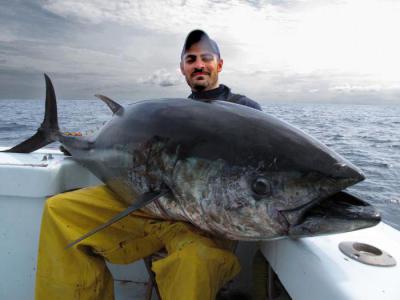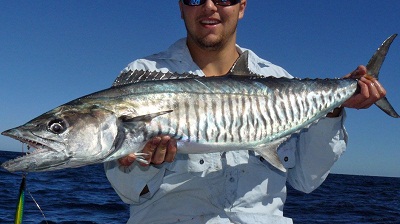SAILFISH :
|
A sailfish is a fish of the genus Istiophorus of billfish living in colder areas of all the seas of the earth. They are predominantly blue to gray in color and have a characteristic dorsal fin known as a sail, which often stretches the entire length of the back. Another notable characteristic is the elongated bill, resembling that of the swordfish and other marlins. They are, therefore, described as billfish in sport-fishing circles. The sail fish grow quickly, reaching 1.2–1.5 m in length in a single year, and feed on the surface or at middle depths on smaller pelagic forage fish and squid. Sailfish were previously estimated to reach maximum swimming speeds of 35 m/s (130 km/h During predator–Generally, sailfish do not grow to more than 3 m in length and rarely. The sail is normally kept folded down when swimming and raised only when the sailfish attack their prey. |
 |
 |
Sailfish usually attack one at a time, and the small teeth on their bills inflict injuries on their prey fish in terms of scale and tissue removal. Sailfish are legendary marine animals, worshipped by ancient cultures as sacred fish and pursued around the world by famous anglers. There's something magical about that big blue sail that draws anglers in. Sailfish is a carnivorous fish that can be found throughout the warm and temperate regions of the oceans. There are two main subspecies of sailfish – the Atlantic and Indo-Pacific. Sailfish can grow from 5.7 feet up to 11 feet and can weigh between 120 to 220 lbs. On average, a sailfish can live up to seven years. |
DOLPHIN FISH ( DORADO, MAHI-MAHI) :
|
The Dolphin fish is a surface-dwelling ray-finned fish found in off-shore temperate, tropical, and subtropical waters worldwide. Also widely called Dorado and dolphin, it is one of two members of the family Coryphaenidae, the other being the pompano dolphin fish. The Dolphin fish have compressed bodies and a single long-based dorsal fin extending from the head almost to the tail. Mature males have prominent foreheads protruding well above the body proper. Females have a rounded head. Their caudal fins and anal fins are sharply concave. They are distinguished by dazzling colors - golden on the sides, and bright blues and greens on the sides and back. The pectoral fins of the mahi-mahi are iridescent blue. The flank is broad and golden. The Dolphin fish can live for up to five years, although they seldom exceed four. Females are usually smaller than males. Catches typically are 7 to 13 kg and a meter in length. They rarely exceed 15 kg, and over 18 kg are exceptional. The Dolphin fishes are among the fastest-growing of fish. |
 |
 |
The Dolphin fishes are carnivorous, feeding on flying fish, crabs, squid, mackerel, and other forage fish. They have also been known to eat zooplankton. The Dolphin fish are mostly found in the surface water. Their flesh is soft and oily, similar to sardines. The body is slightly slender and long, making them fast swimmers; they can swim as fast as 50 knots (92.6 km/h, 57.5 mph). Mahi-Mahi are highly sought for sport fishing and commercial purposes. Sport fishermen seek them due to their beauty, size, food quality, and healthy population. Mahi-mahi can be found in the Caribbean Sea, on the west coast of North and South America, the Pacific coast of Costa Rica, the Gulf of Mexico, the Atlantic coast of Florida and West Africa, Indian Ocean, Bay of Bengal, South China Sea and Southeast Asia, Hawaii, Tahiti, and many other places worldwide. |
THE YELLOWFIN TUNA :
|
Yellowfin Tuna are a beautiful and tasty fish found throughout the world in warm waters. They are probably the most commonly caught offshore game fish. They often group together in enormous schools and can be seen breaking the surface chasing after bait. They often follow porpoise around and can be caught under schools of those. The yellowfin tuna is a species of tuna found in pelagic waters of tropical and subtropical oceans worldwide. The yellowfin tuna is among the larger tuna species, reaching weights over 180 kg, but is significantly smaller than the Atlantic and Pacific Bluefin tunas, which can reach over 450 kg, and slightly smaller than the Bigeye tuna and the southern Bluefin tuna. Yellowfin tuna are epipelagic fish that inhabit the mixed surface layer of the ocean above the thermocline. Sonic tracking has found that although yellowfin tuna, unlike the related bigeye tuna, mostly range in the top 100 m of the water column and penetrate the thermocline relatively infrequently, they are capable of diving to considerable depths.
|
 |
 |
Although mainly found in deep offshore waters, yellowfin tuna may approach shore when suitable conditions exist. Yellowfin tuna often travel in schools with similarly sized companions. They sometimes school with other tuna species and mixed schools of small yellowfin, and skipjack tuna, in particular, are commonplace. Like all tunas, their body shape is particularly adapted for speed, enabling them to pursue and capture fast-moving baitfish such as flying fish, and mackerel. Yellowfins are able to escape most predators, because unlike most fish, tuna are warm-blooded, and their warm muscles make them extremely strong swimmers, with yellowfin tuna reaching "speeds of up to 50 miles per hour." They can navigate enormous distances, sometimes crossing entire oceans. |
THE BLUEFIN TUNA :
|
Bluefin are the largest tunas and can live up to 40 years. They migrate across all oceans and can dive deeper than 3,000 feet. Bluefin tuna are made for speed: built like torpedoes, have retractable fins and their eyes are set flush to their body. They are tremendous predators from the moment they hatch, seeking out schools of fish like herring, mackerel, and even eels. They hunt by sight and have the sharpest vision of any bony fish. There are three species of bluefin: Atlantic, Pacific, and Southern. Most catches of the Atlantic bluefin tuna are taken from the Mediterranean Sea, which is the most important bluefin tuna fishery in the world. The body of the bluefin tuna is rhomboidal in profile and robust. The head is conical and the mouth rather large. The head contains a "pineal window" that allows the fish to navigate over its multiple thousands-of-miles range. |
 |
 |
Their color is dark blue above and gray below, with a gold coruscation covering the body and bright yellow caudal fin lets. Bluefin tuna can be distinguished from other family members by the relatively short length of their pectoral fins. Their livers have a unique characteristic in that they are covered with blood vessels (striated). In other tunas with short pectoral fins, such vessels are either not present or present in small numbers along the edges. Fully mature adult specimens average 2 – 2.5 m long and weigh around 225–250 kg. The bluefin possesses enormous muscular strength, which it channels through a pair of tendons to its lunate-shaped caudal fin for propulsion. In contrast to many other fish, the body stays rigid while the tail flicks back and forth, increasing stroke efficiency. It also has a very efficient circulatory system. It possesses one of the highest blood-hemoglobin concentrations among fish, which allows it to efficiently deliver oxygen to its tissues; this is combined with an exceptionally thin blood-water barrier to ensure rapid oxygen uptake. Bluefins dive to depths of 1,006 m .They can reach speeds of 64 km/h. |
GIANT TREVALLY:
|
The giant trevally is a species of large marine fish classified in the jack family, Carangidae. The giant trevally is distinguished by its steep head profile, strong tail scouts, and a variety of other more detailed anatomical features. It is normally a silvery color with occasional dark spots, but males may be black once they mature. It is the largest fish in the genus Caranx, growing to a maximum known size of 170 cm and a weight of 80 kg. The giant trevally is an apex predator in most of its habitats, and is known to hunt individually and in groups. The giant trevally reproduces in the warmer months, with peaks differing by region. |
 |
 |
The giant trevally is both an important species to commercial fisheries and a recognized game fish, with the species taken by nets and lines by professionals and by bait and lures by anglers. The giant trevally for short is largest member of a widespread group of marine fishes collectively known as “kingfishes”. As the name implies they are among the most powerful predatory fishes, and are thus considered a premier angling target throughout their distribution range. Dawn and dusk is the peak hunting times and adult Giant trevally feed predominantly on smaller fish but crustaceans, cephalopods and mollusks are also important in their diet. The giant trevallies are a highly sought-after species, both commercially and recreationally. |
THE SPANISH MACKEREL :
|
Spanish Mackerels are beautifully colored finfish. Their slender bullet-shaped bodies are blue and silver, spotted with golden yellow or olive ovals. They are distinguished from the Cero or King Mackerel in having these spots without stripes on the sides, and in lacking scales on the pectoral fins. Spanish Mackerels are members of the large family of fish that include the Tunas and other Mackerels. Although these fish vary greatly in size, they share many common characteristics including being very fast, powerful swimmers. The average size of Spanish mackerel is from 2-3 KG, while a weight of 9-10 KG is considered large. These torpedo-shaped fish have a long, sleek build with a crescent shaped caudal (tail) fin, ideal for speed and maneuverability. They are blue-green from above and silvery pale all over, with brassy brown oblong spots on their sides. They school at the surface of warm coastal waters of the Western Atlantic, eating smaller fish and migrating with the seasons. A popular food fish, they are carefully managed in both commercial and recreational fisheries, and the population is stable. |
 |
 |
Spanish mackerel are epipelagic, residing at depths ranging from 10-35 m. They are often found in very large schools near the surface of the water. They frequent barrier islands and the passes associated with these islands and are rarely found in low salinity waters. Spanish mackerel larvae occur mostly offshore while juvenile mackerels are found both offshore and in the beach surf. The Spanish mackerel has a fusiform body and a pointed snout which is much shorter than the rest of the head. There are two closely spaced dorsal fins. The first dorsal fin has 17 to 19 spines and originates above the pectoral fin base while the second dorsal fin has 17-20 rays. The caudal fin is falciform. Spanish mackerel have no swim bladder and the body is covered with small silvery scales. This mackerel also lacks scales on the pectoral fins except at the bases as does the king mackerel. The lateral line of the Spanish mackerel gradually slopes down toward the caudal peduncle. The diet of adult Spanish mackerel consists primarily of smaller fish such as herrings, jacks and sardines. This mackerel is also known to feed in lesser quantities on shrimp and cephalopods. |
THE GREAT BARRACUDA:
|
|
The great barracuda is present in tropical to warm temperate waters, in subtropical parts of the Indian, Pacific and Atlantic oceans, from mangrove areas to deep reef, with a lower depth limit of 110 meters. Great barracudas are large fish. Mature specimens are usually around 60–100 cm in length and weigh 2.5–9.0 kg. Exceptionally large specimens can exceed 1.5 m and weigh over 23 kg. In general, barracudas are elongated fish with powerful jaws. The lower jaw of the large mouth juts out beyond the upper. Barracudas possess strong, fang-like teeth that are unequal in size and set in sockets in the jaws and on the roof of the mouth. The head is quite large and is pointed and pike-like in appearance. Barracudas appear in open seas. They are voracious predators and hunt by ambush. They rely on surprise and short bursts of speed (up to 27 mph (43 km/h) to overrun their prey, sacrificing maneuverability. Barracudas are more or less solitary in their habits. Young and half-grown fish frequently congregate in shoals. |
|
Barracudas appear in open seas. They are voracious predators and hunt by ambush. They rely on surprise and short bursts of speed (up to 27 mph (43 km/h) to overrun their prey, sacrificing maneuverability. Barracudas are more or less solitary in their habits. Young and half-grown fish frequently congregate in shoals. Barracuda attacks on humans are rare, although bites can result in lacerations and the loss of some tissue. They are also frequently caught as a source of sustenance, though they are known for the strong odor they release upon being caught. Barracuda are usually caught when fishing for something else. Their sharp teeth often bite through line if you are not using wire. In some places they are not regarded as a prized catch, but I have always liked them because it's always fun to catch something with a wicked mouth full of teeth. Barracudas can reach at least 14 years of age. |
|






